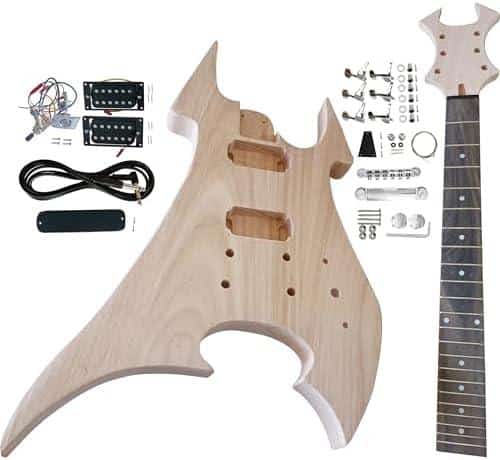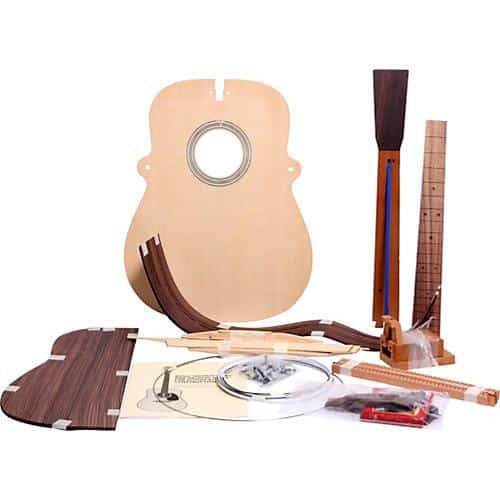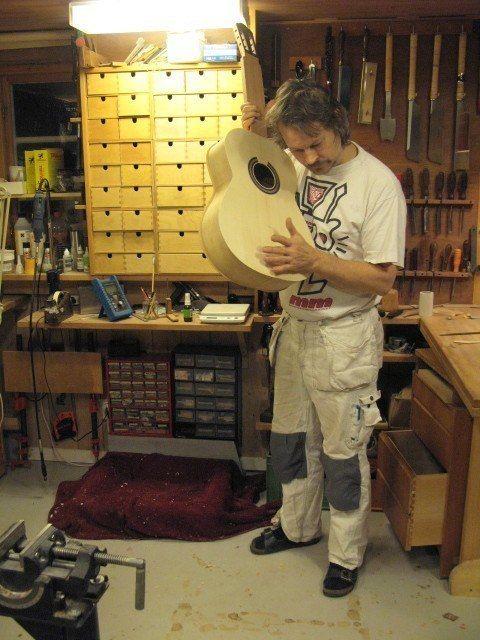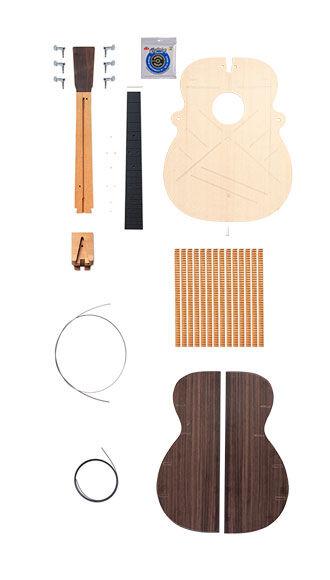I still remember the very first time I laid my hands on a Martin guitar kit. I’d been a luthier for quite some years by then, enjoying the occasional challenge of building a DIY acoustic guitar from scratch. But this was something else entirely. The kit inspired a voltage of excitement I soon found out was more than justified. It felt like being a kid on a Christmas morning, a box full of potential waiting to be pieced together. It was not just a kit; it was an invitation to build your own guitar, a testament to individual creativity, craftsmanship and the indefinable bond between a musician and his instrument. But I digress—let’s get back to where we were.
The world of Martin guitar kits can be thrilling and complex in equal measures, filled with intriguing pathways and decisions that can shape the very voice of your instrument. Did you know that the design of the guitar kit can affect not only the sound and playability but also the personality of the guitar? Intriguing, isn’t it? Stick around as I share my years of experience and knowledge on the subject, navigating you through the vast sea of choices and technical information to help you create a masterpiece that resonates with your vision and sound.
By the end of this comprehensive DIY guide, you’ll hold in your hands not just a beautiful, unique acoustic guitar, but also the satisfaction of knowing every single decision and step that led to its creation. So, let’s get started on this journey. After all, the rundown of riveting components and the allure of creating something uniquely yours await you.
Exploring the Components of Martin Guitar Kits
Understanding Different Kit Models

Having delved into unique aspects of Martin guitar kits, the next fascinating aspect, and the one that truly defines your musical journey, is understanding different kit models available.
I’ve personally assembled several kits, each showcasing its unique appeal. For instance, the East Indian Rosewood Dreadnought Kit appealed to me for its rich, robust tone and remarkable volume, true to the Dreadnought’s reputation. However, the journey took a more refined, intricate turn with the Cutaway guitar kit, known for its sleek design and easier access to the upper frets, allowing me to explore a range of complex tunes.
The Rosewood D-41 guitar kit was another memorable experience with its grandeur and high-end ornate detailing reflected in the high-quality tonal output. It became apparent that the character of these kits was not just a by-product of their components. Each kit was a distinct entity, shaped by singular design philosophy and musical intent.
This understanding can greatly influence the direction of your DIY journey. The model you choose is a reflection of your musical style and aspirations – be it the robust resonance of the Dreadnought, the detailed precision of the Cutaway, or the ornate harmony of the D-41. Exploring these different models became an integral part of my journey, and as you embark on yours, this understanding evolves into an invaluable tool, guiding your decisions and giving shape to your musical dreams.
As we navigate further, let’s turn our attention to the key elements of these kits in the next section.
Key Kit Elements

Having plunged into the fascinating world of guitar-making, it’s been a pleasure to use Martin branded tuners, solid wood kits and other impressive Martin gear. These are a few of the key kit elements that add so much value and charm to the overall experience of crafting your very own, one-of-a-kind Martin guitar.
Solid wood guitar kits are at the heart of the Martin brand. These kits are available in various types of tonewoods, from mahogany to rosewood, and they are precision-cut to ensure not just a perfect fit but also superior sound quality. Each piece of wood is carefully selected and dried to achieve optimal resonance, stability, and aesthetics. This could be considered the bedrock of your kit as the type of wood used will heavily influence the overall sound of your guitar. Martin’s traditional commitment to quality is truly reflected in these exceptional kits.
Another critical component of these kits includes the Martin branded tuners. Unambiguous in their quality and efficacy, these tuners provide precise control over your instrument’s pitch and are designed to maintain accurate tuning over extended periods. They offer durability and reliability, factors that heavily contribute towards creating a guitar that’s as reliable as it is beautiful.
Further, a wide range of Martin gear is included in these kits. These additional tools and resources, from shims and frets to nuts and saddles, help put the finishing touches on your instrument. It’s this comprehensive approach that often makes Martin kits the go-to choice for both novice builders and experienced luthiers alike.
Each of these kit elements is essential, contributing significantly to the quality of your completed instrument. These elements, proprietary to Martin, were designed with careful consideration and decades of expertise. Hence, they ensure a well-rounded guitar-making experience, even if you’re just starting out.
Moving forward, we’ll transition from discussing each component in isolation to understanding different kit models. Each model has its own unique charm, and to truly appreciate what a Martin guitar kit has to offer, we’ll dive into the specifics that make every model truly special.
Buying and Building your Martin Guitar Kit
Where to Purchase

As we navigate this journey of buying and building a Martin guitar kit, it’s crucial to know where to purchase it. With an extensive network in the lutherie community, I have insights into where you can find the best kits, and at the best prices.
Buying a genuine Martin guitar kit ensures that you’re starting with top-notch materials. Not only does this promise a top-tier sound, but equally important, it also guarantees longevity of your instrument. Therefore, by purchasing a genuine Martin kit, you’re essentially setting yourself up for success way before you even start assembling the pieces together.
When choosing a purchase location, one must consider both authenticity and affordability. Official Martin retailers are reliable sources for legitimate guitar kits. However, for those who prefer to shop around, many reputable online music stores and guitar boutiques also stock Martin kits. Prices may vary from place to place, but remember, it’s especially important not to compromise quality for cost when it comes to buying this kit. After all, you’re not just purchasing a product, you’re investing in an experience—the experience of crafting your own personalized instrument from a renown brand.
Moving forward, we’ll delve into the ‘When’ and ‘Where’ to build your Martin guitar, underlining why it matters in the grand scheme of constructing this iconic instrument yourself.
When and Where to Build

After you’ve invested in your Martin Guitar Kit, the thrill of assembling it awaits. An often overlooked yet significant factor is deciding when and where to build.
During my numerous interactions in guitar building workshops, I’ve learned that the importance of choosing the right environment, season, and time cannot be underestimated. From a controlled temperature and hum Automaticity room to a clutter-free workspace with adequate ventilation and lighting, the setting plays a pivotal role in the guitar building process, particularly with an acoustic guitar building project.
Some components of the kit, like the gluing and shellac steps, require the precise ambient temperature and humidity for optimum results. Therefore, taking factors such as season and climate into account is also crucial.
Typically, an ideal workspace would be comfortable and quiet, free from distractions which could potentially affect the precision and focus required for certain tasks. It’s also vital to have an area large enough to store all your tools, materials and the kit itself. Furthermore, I strongly recommend building during the daytime for better visibility and concentration.
Identifying the ideal setting is more than just preference—it impacts the quality of your build and, ultimately, the performance and longevity of your acoustic guitar. Therefore, choosing your building environment thoughtfully is just as important of a step in executing your DIY Martin Guitar Kit as any other.
As we move on to the assembly process, remember that ensuring you’re building under the right conditions will greatly enhance your guitar building experience and influence the finished product immensely.
Assembly Process

Having selected and acquired your Martin Guitar Kit, the real excitement begins: Guitar Kit Assembly. Borne out of an engineer’s love for precision and problem solving, I am thrilled to be your guide for this stage. The harmony of Martin Kit Instructions will come to life in your hands with this process, effectively laying the foundation for your DIY journey.
Following the Martin Kit Instructions diligently is not just quintessential, it’s an art. It’s about identifying the purpose or function of every component. One by one, the unassembled pieces will start forming your dream instrument. The process initially can seem challenging but it’s where the fun and learning lies.
Begin by arranging all the components as per the guideline instructions. The neck, the body, the bridge, and the frets, all the parts of your Martin guitar have their dedicated place, and in the assembly, each deserves your attention. Ensure you have cleaned your working area and your tools are at arm’s length. Double-check each element before securing it into place. The right balance between tightness and flexibility is key, especially when we are talking about strings. You would want to aim for a set-up that is firm yet adjustable.
Over time, the mechanics of guitar kit assembly has taught me patience and observation. A delicate balance of strings, the right angling of the tuning pegs, or the perfect positioning of the bridge, it’s all about the minute details that go into crafting this marvelous instrument.
At the end of this process, you are not just left with a customized Martin Guitar, you also gain a deeper understanding of the construction and functioning of this classic instrument. This assembly process sets the stage for the all-important next chapter of our DIY journey: Understanding Martin Kit Quality & Comparison.
Understanding Martin Kit Quality & Comparison
The Quality of Martin Kits

As we journey deeper into the realm of ‘Understanding Martin Kit Quality & Comparison’, let’s take a closer look at one key element: ‘The Quality of Martin Kits’. Just like a seasoned chef who can instantly identify top-notch ingredients, my accumulated expertise as a long-time guitar craftsman allows me to instantly recognize the high caliber found in Martin’s guitar kits.
First, in terms of guitar kit quality, Martin’s offerings are genuinely top-tier. Their attention to detail, coupled with the use of superior materials, makes these kits a pleasure to work with and ensures a satisfying end result. From the quality of the wood and hardware to the informative instruction booklets, Martin kits come well-equipped to provide an enjoyable hands-on experience.
But more than the assembly process, it’s the Martin kit sound that truly stands out. Martin guitar kits produce some of the best acoustic guitar tones you’ll find in the DIY space. The specific character of sound produced, rich and resonant with a delicate balance in the lows, mids, and highs, can be largely attributed to the quality of the kits. From the pre-shaped and braced soundboard to the fret wire’s precise positioning, each element contributes to Martin’s iconic sound. The end product can stand toe-to-toe with many professional-grade guitars, which is a testament to the phenomenal quality of these DIY kits.
So it’s hardly surprising that, when you read or hear about a guitarist talking about their DIY project, Martin kits often take the limelight. They are in a class of their own in the expansive world of DIY guitar kits.
Aware that this analysis is backed by my sheer hands-on experience and passion, it’s essential to note that quality, in the end, is somewhat subjective – it will always have personal undertones. I implore you to test my assessment for yourself: jump in and start building your very own Martin guitar kit. You’ll find that my words scarcely do justice to the authentic experience of realizing their incredible quality firsthand.
As we transition into ‘Comparing with Other Brands’, remember that experiences can vary, and while the quality of Martin Kits is undisputed for me, it’ll be informative to explore how they stack up against their competition.
Comparing with Other Brands

In the realm of guitar kit comparisons and reviews, it’s beneficial to take a closer look at the disparities between Martin kits and those of other brands. Over the years, I’ve had opportunities to scrutinize and construct kits from different brands, gleaning valuable insights into what sets Martin apart.
A striking strength that sets apart from other brands is Martin’s unyielding dedication to quality. The immaculate craftsmanship evident in every joint, the finely sanded surfaces, and precision-drilled holes make the assembly process a smooth-sail, lending to a robust and beautiful instrument upon completion. In contrast, many other kits I’ve worked with presented challenges—misaligned joints, vague instructions, subpar quality wood—that have resulted in more time than necessary spent on corrections and adjustments during assembly.
Speaking of wood, it’s noteworthy to mention Martin’s choice of high-quality tonewoods. While some kits use cost-effective, low-quality wood types, compromising the guitar’s sound quality, Martin has consistently stuck to their cognitive choice of tonewood. It’s their audacious warranty of rich tonal quality that has kept them as a fan-favorite amongst guitar enthusiasts.
Few other brands can successfully rival the level of precision and detailed information provided in Martin’s instructional documentation. In some other kits, I’ve found omissions, incorrect measurements, and confusing diagrams. Martin’s instructions, however, are both comprehensive and user-friendly, making them a great starting point for novices and a trustworthy guide for seasoned builders.
Martin’s history of continuity helps in their dominance too. Being a heritage brand, they have managed to maintain, and even improve upon, their standards across decades, ensuring each new generation kit remains consistent in quality and design. On the flip side, many brands have inconsistencies in quality across generations of kits.
One thing is clear from this comparison – your kit’s brand matters significantly. From the quality of the materials to the ease of assembly, a superior kit like Martin’s can profoundly affect the final instrument’s quality. Surely, exploring other brands provides breadth; but understanding the depths of Martin kits provides a clearer picture of their definitive edge. It will allow us to appreciate the Martin heritage and their unwavering commitment to quality, which I’ll dive deeper into in the next section.
Building Tips and Tricks

Working on my first custom build guitar, I was eager yet apprehensive, surrounded by an intimidating collection of objects from my guitar construction kit. But with each build over the years, I learned, I improvised, and I grew. I better understood the nuances in guitar finishing, the importance of the right guitar building tools, the artistry behind being a luthier. Over years of trial and error, I managed to navigate the pitfalls that can befall a guitar builder. Let me share with you some valuable experiences, offering tips and tricks that could significantly enhance your DIY process, hopefully saving you from some common missteps.
Ready to unlock some tried and tested secrets that could be a game-changer in your guitar building journey?
Patience is essential. The temptation to rush through the process can be overwhelming, especially when your guitar begins to take shape. Resist it. Each step, each detail, each tiny adjustment is crucial. I’ve learned that quality work needs time and the virtue of patience is gold in a luthier’s world.
Prepare before you begin. Familiarize yourself with the process. Ensure you have all the necessary guitar building tools at hand. A well-organized workspace can significantly enhance efficiency. As a newbie, I spent considerable time searching for tools mid-process. Learn from my mistakes, keep your tools accessible and arranged neatly.
While exploring the components of the Martin Guitar Kit, understand the purpose and placement of each part. Knowledge is power. The more you understand the function and placement of each component, your custom build guitar will likely be better for it.
Don’t be afraid to ask for help. As an independent builder initial years, I sometimes made avoidable errors merely because I didn’t ask for advice. Remember, even the best luthiers didn’t get there overnight. Reach out to fellow luthiers, join online forums, watch tutorial videos, and if possible, find a mentor. Gaining insights from experienced builders enriches your understanding and helps to avoid common pitfalls.
Invest in high-quality finishing. Guitar finishing is where your craftsmanship truly shines. A well-finished guitar body primes it for better sound and aesthetic appeal. During my initial builds, I underestimated this aspect, focusing more on the construction than the finishing. Bad move. Always dedicate ample time and attention to finishing your custom build guitar. It can make a significant difference to the final outcome.
Building a guitar from a kit isn’t easy. Mistakes can be costly. But, with these little tips in your arsenal, your guitar building journey can be smoother, more enjoyable, and potentially less prone to errors. Remember, every build is a new learning experience, every mistake a lesson. So, keep at it, take it one step at a time, and soon you’ll be strumming on the guitar of your dreams – built with your own hands.
FAQs
What is a Martin Guitar Kit?
How difficult is it to assemble a Martin Guitar Kit?
What tools do I need to assemble a Martin Guitar Kit?
Where can I purchase a Martin Guitar Kit?
Conclusion
Throughout this guide, we’ve embarked on an enlightening journey into the world of DIY acoustic guitar building. We’ve explored every detail of Martin guitar kits, understanding different models, scrutinizing key elements, and learning where to purchase and how to craft our masterpiece. The beauty is, this isn’t just about building your own guitar – it’s about fostering a relationship with the instrument, understanding its nuances, and appreciating the quality of Martin kits as compared to other brands.
Ever thought building your own Martin guitar could be more than a hobby, but a deeply fulfilling journey of self-exploration? As someone who’s drawn immense joy from this DIY pursuit, I passionately advocate this path. Not only does it test your skills and patience, but every pluck of a string on a guitar you built, resonates a note of personal achievement.
The tips and tricks along with the FAQs shared should ease your process, but remember, this journey is best savored at a leisurely pace. Embrace the occasional hiccup and let it add to your experience.
So, take the leap, build your own guitar, and join the legacy of lovers of Martin’s quintessential American craftsmanship. If you feel a deep resonance with the guitar as an instrument, building your own could be the most rewarding experience you’ll ever embark upon.